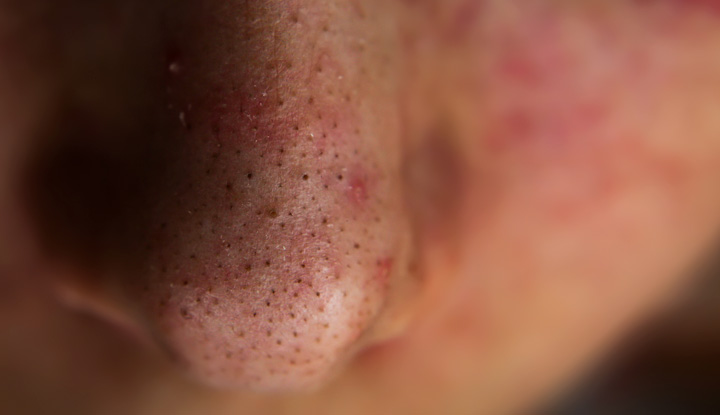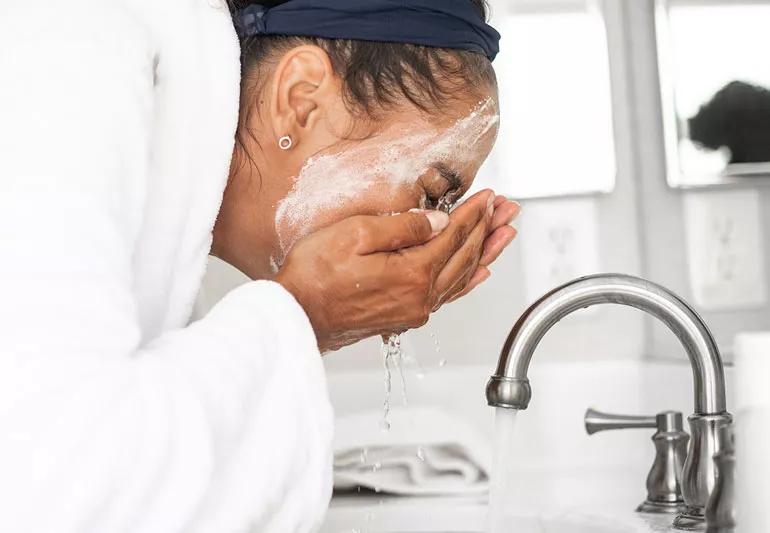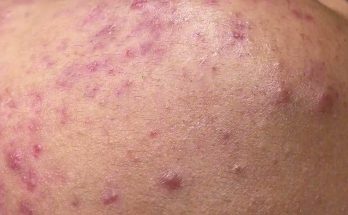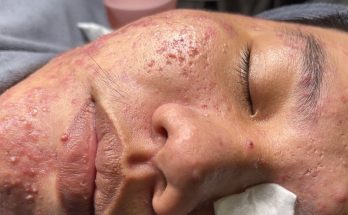Blackheads
Blackheads are a very common skin condition that mostly affects your face, neck, back and chest. There are a variety of causes, including too much oil on your skin and hair follicle irritation. Blackheads commonly affect adolescents, but they can occur at any age.

What are blackheads?
Blackheads are a type of acne (acne vulgaris). They’re open bumps on the skin that fill with excess oil and dead skin. They look as if dirt is in the bump, but an irregular light reflection off the clogged follicle actually causes the dark spots.
Blackheads aren’t pimples. Pimples are small, painful, discolored bumps with a thick, white-yellow fluid (pus) at the tip.
Who do blackheads affect?
Blackheads typically affect teenagers and young adults undergoing hormonal changes. However, many adults continue to have acne into their 20s, 30s and beyond. Some even develop blackheads for the first time as adults.
How common is this condition?
Blackheads are very common. Some researchers suggest that blackheads affect nearly everyone during their lives. They’re most common among adolescents, but up to 10% to 20% of adults have blackheads too.
How do blackheads affect my body?
Your face (especially your nose and chin, sometimes your cheeks), neck, back and chest are most likely to develop blackheads. However, oil (sebaceous) glands are all over your body. They release an oily lubricant called sebum that helps keep your skin and hair hydrated and shiny. As a result, though it isn’t common, blackheads sometimes appear on your butt, thighs, ears and armpits.
Blackheads don’t seriously affect your physical health, but they can affect you psychosocially (how society and social groups affect your mind) and psychologically (your self-perception and behavior). Blackheads can cause anxiety, depression, mood disorders and suicidal thoughts.
Symptoms and Causes
What are the symptoms of blackheads?
Blackheads are a milder form of acne. Dark, open bumps in your skin are the main characteristic of blackheads. They don’t hurt or feel uncomfortable like whiteheads.
What causes blackheads?
Sebaceous glands are located all over your body, and most of them connect to hair follicles. Blackheads and whiteheads are comedones (singular comedo). Blackheads are open comedones, and whiteheads are closed comedones. Comedones occur when a hair follicle/sebaceous gland becomes inflamed. Inflammation can occur as a result of:
- Increased sebum (oily material produced by the sebaceous gland) production.
- Abnormal formation of keratin (the protein that helps make your hair, skin and nails).
- Increased hormones (androgen).
- An increased presence of bacteria on skin that causes acne.
Are blackheads contagious?
Blackheads aren’t contagious. You can’t spread blackheads to another person through skin-to-skin contact.
Diagnosis and Tests
How are blackheads diagnosed?
Blackheads are easy to recognize, so you don’t necessarily need a healthcare professional to diagnose them. If you have blackheads along with other severe forms of acne, see a dermatologist for treatment. Dermatologists are doctors who specialize in conditions that affect your skin, hair and nails.
Management and Treatment
How are blackheads treated?
Nonprescription medications can treat blackheads. These may include:
- Salicylic acid: This is available over-the-counter for blackheads as a cleanser or lotion. It helps remove the top layer of damaged skin. Salicylic acid dissolves dead skin cells to prevent your hair follicles from clogging.
- Azelaic acid: Barley, wheat, rye and other various grains naturally contain azelaic acid. It kills microorganisms on your skin and reduces swelling.
- Benzoyl peroxide: This is available as an over-the-counter product (such as Clearasil®, Stridex® and PanOxyl®) as a leave-on gel or wash. It targets surface bacteria, which often aggravates acne. Lower concentrations and wash formulations are less irritating to your skin. Irritation (dryness) is a common side effect.
- Retinoids (vitamin A derivatives): Retinoids, such as Retin-A®, Tazorac® and Differin® (which is now available without a prescription), break up blackheads and whiteheads and help to prevent clogged pores. You may notice a change in skin color or peeling. Using retinoids every other day or using them at the same time as a moisturizer can reduce these side effects.
If your blackheads don’t go away with nonprescription medications, your healthcare provider may recommend:
- Prescription-strength retinoids: Prescription-strength retinoids are stronger than nonprescription retinoids.
- Oral antibiotics: Oral antibiotics reduce the bacteria that cause blackheads.
- Microdermabrasion: A dermatologist uses a specialized instrument to “sand” your skin. Removing the top layers of your skin frees the clogs that cause blackheads.
- Chemical peels: Chemical peels use a mild chemical solution to remove layers of skin and reduce blackheads.
- Laser skin resurfacing: Laser skin resurfacing directs short, concentrated pulsating beams of light at your blackheads. The light beams reduce the amount of oil that your sebaceous glands produce.
Are there any home remedies for blackheads?
There are a few home remedies that may help treat blackheads:
- Tea tree oil: Tea tree oil can prevent or stop the growth of bacteria. Apply a small amount of tea tree oil to a cotton applicator and rub it on your blackheads.
- Sugar or salt scrubs: Sugar and salt scrubs scratch away (exfoliate) dead cells on the surface of your skin. Wet your face, apply a salt or sugar scrub to your affected areas and massage your skin in small, circular motions for up to 30 seconds. Rinse your face with water when you’re finished.
- Green tea: Wet green tea leaves can help reduce oil production in your skin. Green tea is also an antioxidant. Mix dry green tea leaves with water and massage the wet leaves into your skin in small, circular motions for up to 30 seconds. Rinse your face with water when you’re finished.
Do blackheads go away on their own?
Blackheads can sometimes go away on their own — it depends on how deep blackheads are in your skin. If a blackhead is close to the surface of your skin, it’s more likely to go away on its own. However, some blackheads can be deeply embedded in your skin. Deep, embedded blackheads are less likely to go away on their own. If you have embedded blackheads, a dermatologist or medical aesthetician can remove them.
Is it okay to squeeze out blackheads?
It can be very tempting — and satisfying — to squeeze out or pop blackheads. However, squeezing out blackheads can create several problems:
- You may not remove the entire blackhead. You may even push the blackhead further into your skin, which can cause painful irritation.
- You may introduce bacteria or more oil into the blackhead opening. Your blackheads could get bigger or even spread.
- Inflammation or scarring. Your skin is sensitive, and your nails are much stronger than your skin. When you use your nails to apply a lot of pressure to your skin to remove a blackhead, you can irritate or seriously damage your skin.
How do you get rid of deep blackheads?
Deep blackheads should be removed by a medical professional — usually a dermatologist or medical aesthetician. They use a small tool with rigid metal loops on the ends (blackhead or comedo extractor) to apply even pressure to your blackheads. They can safely remove the entire blackhead and reduce the risk of it returning.
Prevention
How do you prevent blackheads?
Preventing blackheads is difficult, if not impossible, during normal hormonal changes. But some things can help:
- Wash your face daily with warm water and a mild facial cleanser.
- Routinely use moisturizer.
- You don’t have to stop using makeup, but try to use “noncomedogenic” products and remove makeup at the end of each day.
- Keep your hands away from your face.
Outlook / Prognosis
What can I expect if I have blackheads?
Blackheads often go away in early adulthood, though some people will continue to experience them throughout their lives. Your healthcare provider, medical aesthetician or dermatologist can help you manage your blackheads.
Living With
When should I see my healthcare provider about my blackheads?
See your healthcare provider as soon as you notice blackheads to start treatment immediately.
What questions should I ask my healthcare provider?
- How severe are my blackheads?
- Do I need to see a medical aesthetician or dermatologist?
- What over-the-counter medications do you recommend?
- Do I need more serious treatment?
A note from Cleveland Clinic
Blackheads are a common skin condition that affects the majority of people, especially adolescents. Because it mainly affects adolescents, many people attribute blackheads as part of the transition from childhood to adulthood and don’t see a healthcare provider about them. However, despite how common they are, they can have a severe effect on your mental health. If you notice symptoms of anxiety or depression due to the presence of blackheads, talk to your healthcare provider.
How To Get Rid of (and Prevent) Blackheads: 10 Solutions
Try exfoliating and using salicylic acid to treat this pesky skin care issue
Is there anything more annoying than seeing little black specks on your face?
We’ve all stood in front of the mirror and examined our pores from time to time, cursing our skin. But if the appearance of blackheads on your face really does bother you — rest assured, there are ways to get rid of them.
Dermatologist Alok Vij, MD, discusses how to get rid of blackheads and offers tips to prevent new ones from forming.
How to get rid of blackheads at home
“There are a few different ways we can attack blackheads,” says Dr. Vij. “But I do stress to be patient with your skin and that consistency is key. It took a while for your skin to get to this place and it will take a little while to get it back to where it was before.”
Learn how to remove blackheads with these tips:
Opt for salicylic acid
“My go-to treatment for blackheads is recommending a salicylic acid wash once a day,” he says. “There are even medicated face wipes that contain it.”
If you want to try salicylic acid, start off by using a product that contains between 2% and 4%. Then, you can modify the amount used by how your skin reacts. If it’s drying you out, opt to go down a bit.
Use an alpha or beta hydroxy acid cleanser
Alpha or beta hydroxy acid, also known as AHAs and BHAs, are a group of compounds known for its skin care benefits. Some of the most popular elements in this group include salicylic acid, lactic acid and citric acid.
Another great option for removing blackheads in the AHA family is using a product containing glycolic acid. Aim to use a cleanser with 10%. Glycolic acid serves as a great exfoliator, helping to remove the outer layer of dead skin cells — and those annoying blackheads.
Try a retinoid
“From a medical standpoint, I’ll typically prescribe a topical retinoid as treatment,” says Dr. Vij. “It’s good for making sure that the dead skin cells aren’t collecting inside the pores. It also helps to prevent outbreaks and reduces the formation of acne scars.”
Sometimes, it works to split treatment between a retinoid and an alpha or beta hydroxy acid. An example treatment could be using a salicylic acid cleanser in the morning and a retinoid at night.
Make sure you exfoliate
Exfoliation is an important part of every skin care routine — but it’s very easy to overdo.
“You should really only be exfoliating a couple times a week,” explains Dr. Vij. “Over-exfoliating your skin, especially your face, will dry it out very quickly.”
What’s worse? When your skin is dried out it produces more oil, which contributes to more blackheads. Your best bet is to keep exfoliating to a minimum.
Consider in-office treatments for stubborn blackheads
So, how do you get rid of stubborn blackheads? You may need the assistance of your dermatologist, who may recommend these in-office methods.
Chemical peels
Your dermatologist might suggest a chemical peel. This technique uses a chemical solution to remove your skin’s damaged outer layers. This can result in improved skin texture and smoothness.
But be aware — not all insurances cover these types of treatment.
And depending on whether you have a light, medium or deep chemical peel you may experience redness, stinging and swelling of your skin in the first 48 hours.
Microdermabrasion
Another treatment is microdermabrasion, which is also known as a “power peel.” Your skin is sprayed with tiny crystals to gently sand away your outer layer of skin.
The minimally invasive procedure improves the appearance of your skin. You may have mild side effects like redness, swelling and tenderness for a few hours after your treatment.
And like chemical peels, you may have to pay out-of-pocket for microdermabrasion.
Extraction
Sometimes, a good course of action for stubborn blackheads is by manual extraction, but it should always be kept in the hands of a professional.
Otherwise, you risk scarring your skin.
A professional — whether it’s a dermatologist or esthetician — may prep your skin with a light steam to expand your pores. Then, using a sterile metal tool called a comedone extractor, they’ll apply pressure to the blackhead to remove it from your pore.
Some professionals opt to use their fingers, which are typically covered in cotton, to perform the extraction.
Preventing blackheads
Your best defense against blackheads? Prevention. Here are some things you can do to help prevent or limit how many blackheads you get:
Don’t pick at your skin
While this is easier said than done, it’s vital.
Bacteria and oil are all over your hands, and anytime you touch or pick at your skin, you’re transferring it to your face. It can lead to increased inflammation and additional skin problems, including hyperpigmentation.
Picking at your skin can also cause permanent scarring. We know it’s hard, but try to resist.
Choose the right makeup and skin care products
If you’re serious about putting an end to pesky blackheads, be mindful about the products you put on your face.
Noncomedogenic makeup and skin products are specifically designed to not clog your pores. Using these types of products can help cut down on the number of blackheads you have. Dr. Vij also stresses the importance of using a facial moisturizer with an SPF of at least 30.
And try to avoid wearing oily and heavy products. A good rule of thumb is the thinner the product, the better. Anytime something is on your skin — even a moisturizer — it has the potential to clog your pores.
Tread lightly with pore strips and face masks
If you’ve been wondering how to get rid of blackheads on your nose, you may have turned to pore strips or skin care face masks.
Adhesive strips and skin care masks tend to have the immediate gratification that most people are looking for, but oftentimes, these products don’t solve the underlying skin issue at hand.
“Pore stripes use an adhesive to lift the congestion out of the pore, which can be helpful if you’re getting ready for an event. For example, a teenager who wants to get ready for prom,” notes Dr. Vij. “But it will really only temporarily clear your skin and can have some side effects such as excess irritation and dryness.”
So, while it’s good advice to tread lightly with pore strips and skin care masks, they can serve a purpose from time to time. If you’re a savvy skin care user, ask your dermatologist about what products they recommend. This way, you can minimize the risk of using a mask or strip that could potentially irritate your skin.
While blackheads can be annoying and even embarrassing there are ways to combat the skin care issue — and it’s key to find a solution that works best for you and your skin type.
“Every skin type is different and should be treated that way,” states Dr. Vij. “And part of my job is to help you figure out what combination of treatment works for your skin.”



